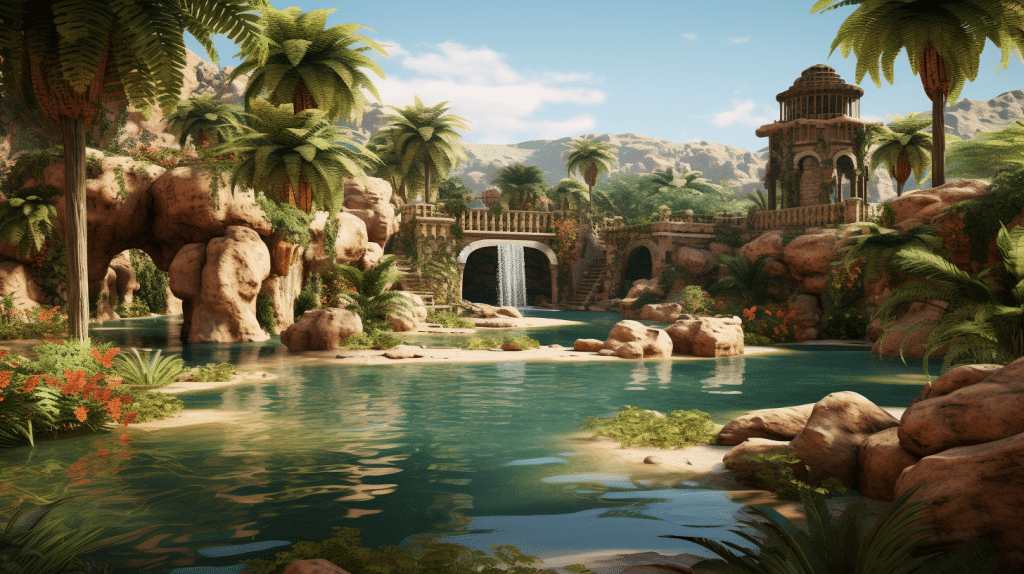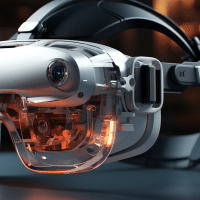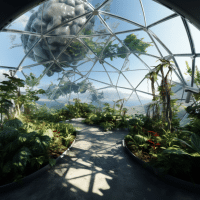
Virtual Reality (VR) technology, once primarily associated with gaming and entertainment, has rapidly expanded its influence across a diverse range of industries. From healthcare to real estate, VR is proving to be a transformative tool that enhances experiences, improves training, and revolutionizes various processes. This article delves into the far-reaching impact of VR beyond the gaming realm, exploring how it is reshaping industries such as healthcare, education, architecture, tourism, and real estate.
The Evolution of VR: From Entertainment to Application
Virtual Reality, a simulated experience that can be similar to or completely different from the real world, has come a long way since its inception. Initially, VR gained prominence in the gaming sector, offering immersive environments and interactive experiences.
However, its potential was soon recognized across various sectors due to its ability to create realistic, immersive environments that simulate real-world scenarios.
The development of more accessible and affordable VR hardware, coupled with advancements in software and content creation, has paved the way for VR’s integration into industries beyond gaming.
The Evolution of VR: From Entertainment to Application
In the realm of technological innovation, few concepts have captured the imagination of both creators and consumers quite like Virtual Reality (VR). What began as a niche entertainment experience has rapidly evolved into a transformative tool with applications spanning industries as diverse as healthcare, education, architecture, and more.
The journey of VR from its early roots to its current state as a versatile application has been nothing short of remarkable, offering insights into the dynamic interplay between human curiosity, technological advancements, and societal needs.
The Genesis of Virtual Reality: A Glimpse into the Past
The concept of creating immersive artificial environments has long been a fascination for scientists and visionaries. The foundations of VR can be traced back to the early 20th century, with the invention of the stereoscope—an apparatus that provided a sense of depth and three-dimensionality to images. However, it wasn’t until the mid-20th century that technology and imagination truly began to converge.
One of the pioneering moments in the evolution of VR came in the 1960s when Ivan Sutherland and his student, Bob Sproull, developed the “Sword of Damocles,” a head-mounted display system that laid the groundwork for immersive experiences. The device was large and cumbersome, but it demonstrated the potential for creating simulated environments that responded to user movements.
The Entertainment Era in Evolution of VR: From Novelties to Mainstream Appeal
As computing power increased in the following decades, so did the potential for more sophisticated VR experiences. The 1990s saw a surge of interest in virtual reality, with companies like Sega and Nintendo introducing VR-related peripherals for gaming consoles. However, the technology of the time struggled to deliver the seamless and immersive experiences promised, leading to a period of disillusionment known as the “VR Winter.”

The turning point came in the 2010s, when advancements in computing, graphics, and motion tracking reinvigorated the field. Oculus Rift, introduced in 2012 as a Kickstarter project, marked a pivotal moment in the history of VR. The Rift’s combination of head-tracking, stereoscopic 3D, and responsive interfaces laid the foundation for modern VR systems.
Subsequent releases from companies like HTC (Vive) and Sony (PlayStation VR) further solidified the renewed interest in VR as a potential entertainment medium.
Beyond Entertainment: VR’s Journey into Real-World Applications
While VR’s initial resurgence was primarily driven by its gaming and entertainment potential, innovators soon began to realize its broader applications. The transition from entertainment to application was marked by the realization that VR could do more than just entertain—it could educate, simulate, and revolutionize various industries.
The Stunning Evolution of VR in Different Fields
1. Education and Training:
One of the first sectors to embrace VR’s transformative potential was education and training. From medical students practicing surgeries in simulated environments to soldiers honing their combat skills in virtual battlegrounds, VR proved invaluable in creating safe and controlled spaces for learning and skill development.
2. Healthcare and Therapy:
The medical field saw the emergence of VR as a tool for therapy and treatment. Patients with anxiety disorders, phobias, or PTSD could confront their fears in controlled VR healthcare environments, facilitating a gradual and supervised healing process. Moreover, VR found utility in pain management and physical rehabilitation, providing engaging distractions to alleviate discomfort during treatments.
3. Architecture and Design:
Architects and designers leveraged VR to transform the way they conceptualized and presented projects. VR allowed clients to virtually walk through unbuilt spaces, assessing dimensions, materials, and aesthetics in an immersive manner. This not only enhanced communication between architects and clients but also led to more informed design decisions.
4. Real Estate and Tourism:
In the real estate and tourism sectors, VR empowered potential buyers and travelers to explore properties and destinations remotely. This not only saved time and resources but also democratized access to information, enabling individuals to make more informed decisions.
5. Collaboration and Remote Work:
The rise of remote work and distributed teams prompted the integration of VR into collaboration tools. Virtual meeting spaces and shared work environments allowed colleagues from different parts of the world to interact as if they were in the same physical space, fostering a sense of presence and camaraderie.
Technological Enablers: The Evolution of Hardware and Software
The evolution of VR wouldn’t have been possible without the confluence of hardware innovation and software development. As VR moved from mere entertainment to diverse applications, both aspects underwent significant transformation.
1. Hardware Advancements:
The hardware journey of VR has been marked by continual refinement and miniaturization. Early headsets were bulky and heavy, often causing discomfort during prolonged use. However, advancements in display technology, optics, and ergonomics led to the creation of more comfortable and immersive headsets. Additionally, the integration of hand controllers and haptic feedback devices heightened the sense of presence, enabling users to interact naturally with VR healthcare environments.
2. Software Ecosystem:
Equally critical was the growth of the VR software ecosystem. Content creation tools, game engines, and development platforms evolved to accommodate the demands of diverse applications. Developers harnessed these tools to create experiences that were not only visually captivating but also interactive and meaningful. The evolution of user interfaces and intuitive navigation further contributed to making VR accessible to a wider audience.
Challenges and Future Prospects
While the evolution of VR has been impressive, it has not been without challenges. The high cost of quality hardware, motion sickness concerns, and the need for compelling and diverse content have presented hurdles to widespread adoption. However, ongoing research and development are addressing these issues, and the future of VR looks promising.
As VR continues to evolve, its potential applications are boundless. From revolutionizing how we learn and work to enhancing therapeutic interventions and shaping the way we design and experience spaces, VR is poised to reshape our interaction with the digital and physical worlds. As technology becomes more accessible and user-friendly, the democratization of VR is likely to accelerate, ushering in a new era of innovation and creativity.
Best VR Games of This Year – Explore Around!
Conclusion
The journey of VR from its inception as a concept to its current state as a versatile tool has been a testament to human ingenuity, technological progress, and the power of imagination. What began as a novel form of entertainment has grown into an invaluable tool with applications across industries and domains.
As VR’s hardware and software continue to advance, and as its potential is increasingly realized, we find ourselves at the cusp of a new age—one in which virtual reality is not just a curiosity but an integral part of how we learn, work, play, and experience the world. The evolution of VR serves as a reminder that the boundaries of possibility are ever-expanding, and that the future is limited only by the scope of our imagination.
Healthcare: Enhancing Diagnoses, Treatment, and Training
In the healthcare industry, VR is making significant strides by enhancing medical procedures, diagnoses, and treatment plans. Medical professionals can use VR to visualize complex anatomical structures, helping them better understand patient conditions and plan surgeries with greater precision. For instance, surgeons can use VR to simulate surgeries before performing them, reducing the risk of errors and improving patient outcomes.
Additionally, VR has proven effective in pain management and therapy. Patients undergoing painful treatments can be immersed in calming, VR healthcare environments that help alleviate discomfort and anxiety. This approach has shown promising results in distraction therapy during wound care, dental procedures, and physical therapy sessions.

Medical training is another area benefiting from VR technology. Medical students can practice surgical procedures in a risk-free virtual environment, enhancing their skills before working on real patients. VR also enables collaborative training sessions, where students and professionals from different locations can participate in the same simulated scenario.
Education: Creating Immersive Learning Environments
Education is experiencing a revolution with the integration of VR. Traditional teaching methods are being enhanced by immersive learning experiences that cater to various learning styles. For example, history lessons can be transformed as students virtually explore ancient civilizations, science classes can include interactive trips through the human body, and geography lessons can become global adventures.
VR Exercise: Get Fit While Exploring Virtual Worlds
VR Guide for Absolute Beginners
Field trips that were once limited by logistics and costs can now be easily simulated through VR. Students can “visit” historical landmarks, natural wonders, and cultural sites from the comfort of their classrooms. This not only expands their horizons but also deepens their understanding of the subject matter.
Furthermore, vocational and technical training are benefitting from VR simulations. Pilots can practice flying in various conditions, mechanics can troubleshoot virtual engines, and trainee chefs can experiment in virtual kitchens. This hands-on training approach reduces the risk associated with learning on real equipment and increases competence before entering the workforce.

Architecture and Real Estate: Designing and Exploring Spaces
In architecture and real estate, VR is transforming the way projects are conceptualized, designed, and presented. Architects can create virtual models of their designs, allowing clients and stakeholders to “walk through” buildings and spaces before construction even begins. This level of immersion helps catch design flaws and make informed decisions early in the planning process, saving time and resources.
For real estate professionals, VR provides a powerful tool for showcasing properties to potential buyers. Virtual property tours enable potential buyers to explore homes and apartments as if they were physically present. This technology is particularly valuable for international buyers who may not have the opportunity to visit in person.
Tourism: Previews and Virtual Expeditions
The tourism industry is leveraging VR to provide travelers with immersive previews of destinations and attractions. Before booking a trip, travelers can take virtual tours of hotels, resorts, and popular tourist sites. This helps manage expectations and aids in decision-making.
Moreover, VR is enabling virtual expeditions to remote or inaccessible locations. Whether it’s exploring the depths of the ocean or embarking on a virtual safari, travelers can experience destinations that might otherwise be beyond their reach. This not only enhances the travel planning experience but also serves as a form of armchair tourism for those unable to travel physically.

Conclusion
As Virtual Reality technology continues to advance, its impact across various industries becomes more pronounced. From healthcare to education, architecture to real estate, VR is proving to be a transformative tool that enhances experiences, improves training, and revolutionizes processes. With its ability to create immersive environments and simulate real-world scenarios, VR has expanded beyond its gaming origins to reshape the way we learn, work, and interact with the world around us.As this technology evolves further, its potential for innovation and positive change is boundless, promising a future where virtual experiences are seamlessly integrated into every facet of our lives.


















